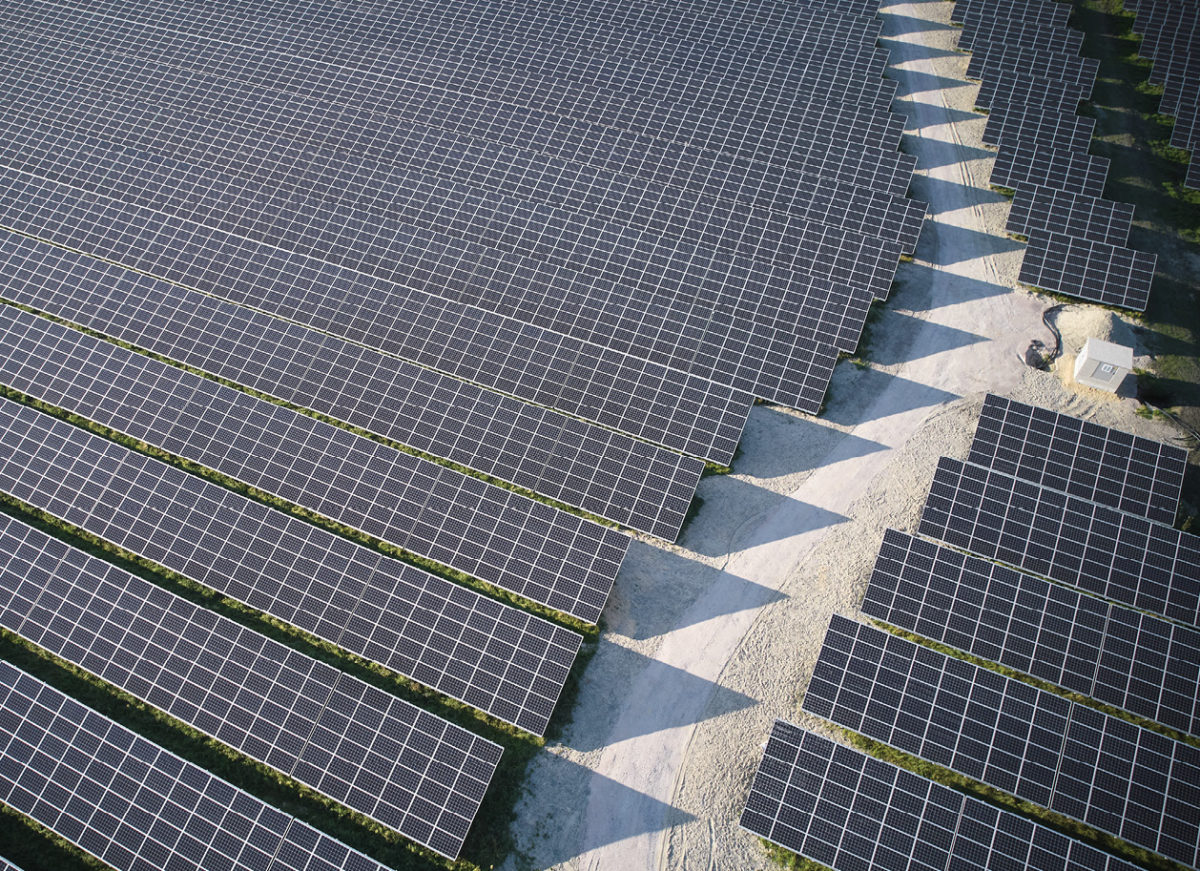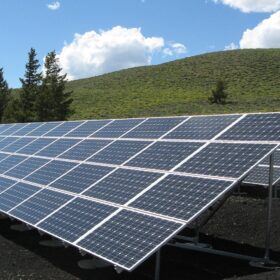It is always dubious to state something is happening “for the first time,” and regardless of whether Enerparc was the first – as one press release claims – or the second or third to build a solar plant marketed primarily as baseload electricity in Germany, the development indicates an emerging trend. We are likely to see that business model more often and it will carry higher risks for operators because baseload means continuous power supply, regardless of whether the sun shines.
Marketing solar via PPAs signed by power companies or industry has established itself in Germany in the last three years, as it has elsewhere. Today, the model is enjoying heady times. “High electricity prices are an additional boost for project planners looking for security in the form of a PPA,” says Thomas Kott, head of portfolio management at Axpo Deutschland.
Under such agreements, operators provide power and receive either “pay-as-produced” or “pay-as-forecast” returns. The customer receives electricity when the sun shines. That means lots of power at midday in summer, much less in winter, and nothing at night. Unless the power is used solely for air conditioning, consumers usually require a different profile and have to consider how to fill the gaps.
The approach is more established in markets outside of Germany. In Spain, 10% to 20% of solar PPAs are already baseload-plant driven, according to David Willemsen who, as head of risk consulting at Pexapark, advises generators on supply contracts. For wind PPAs in the Nordic states the model has a firm foothold. In Spain, “it was long seen as standard practice for contracts to run for 10 years, like in the USA,” says Jan Knievel, head of origination at Enerparc electricity trading subsidiary Sunnic Lighthouse. In Germany, however, contracts typically only lasted around four years.
Baseload shift
What does marketing solar with a baseload PPA entail when, as Knievel points out, “no solar plant can deliver baseload.” Swiss energy supplier Axpo takes delivery of electricity from the 39 MW solar plant in Büttel, which Enerparc holds as an investor. With a 4 MW baseload band agreed, and 8,760 hours in a year, that means 35 GWh of electricity annually, a figure close to the expected yield of such a site. But the sun does not shine continuously with the same consistent intensity.
While the solar output of German sites in August is around 60% above the annual average figure, in December it is only a quarter of the mean. For baseload supply, all fluctuations must be balanced. “If the plant produces less than 4 MW, we have to buy power and if the plant produces too much, we have to sell,” says Knievel. The contract lasts 10 years so running the numbers involves assumptions about electricity buying and selling prices for a decade. With pay-as-produced contracts, buyers bear the risk, but with baseload contracts the risk is initially with the seller.
Securing project development via the so called “innovation” tender ensures every kilowatt-hour is remunerated with a fixed, single-digit euro-cent amount, even if sold via a PPA. The power plant must be equipped with a battery, however, which can help supply baseload power but is never going to be the complete solution.
“The capacity is not enough for that,” says Knievel. “With the 8 MWh battery, we can supply the 4 MW for two hours.” Planning a battery large enough to balance out the energy supply from solar, including seasonal shifts, is unrealistic, so electricity trading has to be a factor.
Utilities such as Axpo have in-house trading expertise – and the financial clout to bear price risk. Generally, though, PV plants are built and operated by limited liability special purpose vehicles (SPVs) which have to take the risk of a baseload PPA. Although, the bank lending to the SPV is given access to the assets – the PV plant – as collateral. The lender must ensure the SPV’s other obligations, included in the baseload contract, don’t jeopardize the collateral, and that it generates sufficient profits. The fewer risks covered, the lower the loan – and thus, investor return-on-equity – will be.
Refining the model
For the power plant in Büttel, a consortium led by Deutsche Anlagen Leasing (DAL) – with the involvement of savings banks as shareholders – provided the loan financing. “The question baseload contracts address is how to structure the risk of having to buy an unknown amount of electricity at an unknown price,” says Peer Günzel, head of infrastructure and supply sales at DAL.
Germany is often described as an immature market in terms of PPAs and risk appetite, compared to the Nordic nations, Spain, and the US. The approach to solar development in Spain altered after the government drastically cut subsidies a decade ago. That shock left generators looking for new business models, says Günzel.
“PPA structures exist for utility-scale projects – both pay-as-produced and baseload – as a basis for long-term bank financing for projects,” he says, pointing out PPAs are now the bedrock of big renewables.
Market maturity is tied to the ability to assess and manage risk and Büttel is a case in point. Enerparc’s Knievel had worked for a wind-energy electricity trader and Günzel had PV project experience. “It helps when the people involved have experience,” says the latter. At Büttel, Sunnic Lighthouse has assumed the risk of the difference between baseload and actual production. For a fee, the Enerparc subsidiary will meet the project company’s supply obligations.
Cannibalizing profits
Demand for baseload PPAs is due in part to the history of the electricity market. They constitute a standardized product and “traders know how to deal with that,” says Pexapark’s Willemsen.
Another advantage is that baseload deals take the pressure off electricity buyers: currently the big energy companies. “Even the big, creditworthy buyers have to price in the risks when they do a pay-as-produced PPA and hold risk capital,” says Axpo’s Kott. “At some point, even a big offtaker like Axpo, or another creditworthy buyer, will say: ‘I’ve had enough of pay-as-produced risks, now I’ll just stick with baseload deals.’”
One of the biggest market price risks is the “cannibalization” effect. The theory that solar generation, during peak sunlight periods for photovoltaics, proves so effective in driving down the price of electricity that it affects its investors’ business case is nothing new, and the phenomenon can now be quantified.
Last year, the average German market value of solar power was €0.07552 ($0.07443)/kWh, some 22% lower than the annual average exchange electricity price of €0.09685/kWh. Solar generators that sold electricity on a baseload contract received less for the surplus during the day, and in summer, than they had to spend at night and in winter to balance the supply. Traders buying power to cover shortfalls and selling surplus power would have lost 22% of the baseload value in 2021. This is what experts call the capture factor, market value factor, or profile factor.
If the future capture factor were known, it could be accounted for and baseload contract pricing would be less challenging. But how the price will develop over 10 years is one of the great unknowns. Capture factor projections, which also reflect the expected expansion of renewables, for Germany range from 40% to 70%.
Operator upside
The shift to baseload contracts does not have to be negative for investors, however. Market price risks come with a price tag. If a generator today earns around €0.165/kWh over a 10-year pay-as-produced PPA, they might charge €0.20/kWh for a baseload PPA, according to Willemsen. Bespoke deals are also an option, he points out, such as monthly baseload contracts that take into account average four-week solar generation.
It can even be profitable for investors to retain the risks and conclude higher baseload contracts, under certain circumstances, according to a recent brochure published by Pexapark. When selling to an energy company, that can include managing “settlement” – the purchase and sale of shortages or surpluses.
It may be possible in future for solar plant operators to mitigate energy supply risks directly by using batteries or combining PV with wind turbines. “Co-location with other technologies can not only save grid costs but also increase the profile value,” says Willemsen. “Depending on the design of the storage system, you can achieve a market value that is higher than the baseload.”
To that end, Pexapark this year began calculating hybrid capture factors for systems with battery storage. “For a PV-storage combination where the storage has 25% of the capacity of the PV plant, we see a market value for the next few years that is 3% to 12% above the baseload,” adds the risk consultant.
First, though, in Germany at least, baseload PPAs need to put down roots. “It works in other markets,” says Willemsen. “A clean assessment of the risk is important. When in doubt, it’s better to hedge a few per cent less than a few per cent too much.”
While rocketing electricity prices are ensuring PPAs are a seller’s market right now – “you can take these extremely high prices on the futures markets for 2023, 2024, and 2025,” says Axpo’s Kott of a situation in which three-year to five-year baseload contracts are popular – longer term prices are currently expected to fall back again.
If that proves to be the case, it will be some time before the market turns around to the point where risk-averse operators have to move away from pay-as-produced deals. However, Kott suspects the German PPA market will evolve as it has elsewhere. “We will also have to move in that direction that there will be more, or perhaps at some point almost exclusively, baseload PPAs for operators,” he says.
Not that operators or energy traders should have to shoulder all the risk, he adds. Industrial energy users can play their part, too. “They can’t expect to get green power for a small premium, from super-nice plants with additionality, without taking on any risk at all,” Kott says. If energy users secure finance by taking on the market price risk of a clean energy plant, they can truly say the generation project was built due to their commitment to renewables – so called “Additionality.”
Corporate PPAs
Andreas Loh, managing director of Enovos Energie Deutschland, agrees. Enovos’ PPA concept is that the large industrial power buyers will structure the PV generation and assume the associated risks.
At one time, Loh explains, industrial companies signed PPAs on a fixed forecast basis but now “this is changing in the course of the energy transition, when the volatility of energy trading prices is increasing significantly due to the much less predictable power generation of renewable plants.”
The risk of selling or buying at a certain point is now on the consumer, and big companies have the market knowledge and the capability to adjust loads in tandem with spot market prices. “Many companies and start-ups, like Enovos itself, are now developing automation logic for this,” says Loh, adding that also leads to technical solutions to deal with fluctuating solar insolation.
Google, a major energy consumer, is pursuing a different approach, explained Marc Oman, the search engine’s head of energy and infrastructure in Europe, the Middle East, and Africa. Speaking at this year’s pv magazine Roundtables Europe event, Oman said Google’s goal is not only to supply its data centers with renewable energy, on a balance-sheet basis over the year, but to also cover hourly consumption.
As part of that drive, the US giant is supporting efforts by firms such as Energytag to time-stamp electricity. Baseload contracts are not part of the picture because Google believes generators should not be using gray power from the electricity exchange to enable a shift from pay-as-produced arrangements. Clean power plants should instead deliver just what they produce, with the consumer – Google – developing extra generation facilities and storage as required.
That approach would certainly tackle price cannibalization, but dissenting voices say having individual companies time stamping just their own green power would be more costly than optimizing the whole system. They maintain that price signals from the electricity market, which determine the difference between baseload and pay-as-produced PPAs, are enough to motivate the construction of storage and electrolyzers and could also motivate much-needed flexibility in energy consumption.
This content is protected by copyright and may not be reused. If you want to cooperate with us and would like to reuse some of our content, please contact: editors@pv-magazine.com.








By submitting this form you agree to pv magazine using your data for the purposes of publishing your comment.
Your personal data will only be disclosed or otherwise transmitted to third parties for the purposes of spam filtering or if this is necessary for technical maintenance of the website. Any other transfer to third parties will not take place unless this is justified on the basis of applicable data protection regulations or if pv magazine is legally obliged to do so.
You may revoke this consent at any time with effect for the future, in which case your personal data will be deleted immediately. Otherwise, your data will be deleted if pv magazine has processed your request or the purpose of data storage is fulfilled.
Further information on data privacy can be found in our Data Protection Policy.